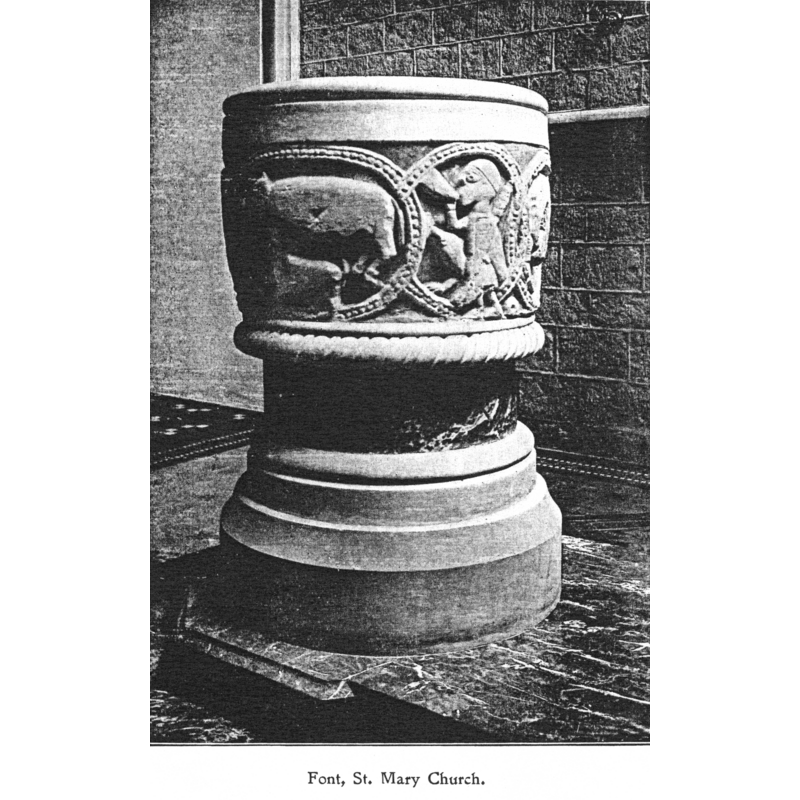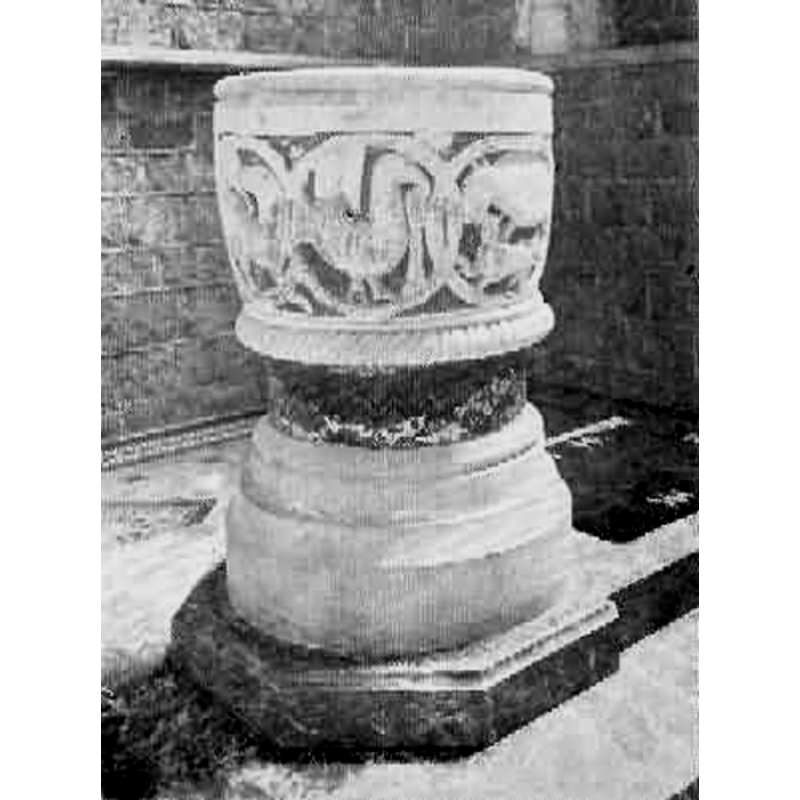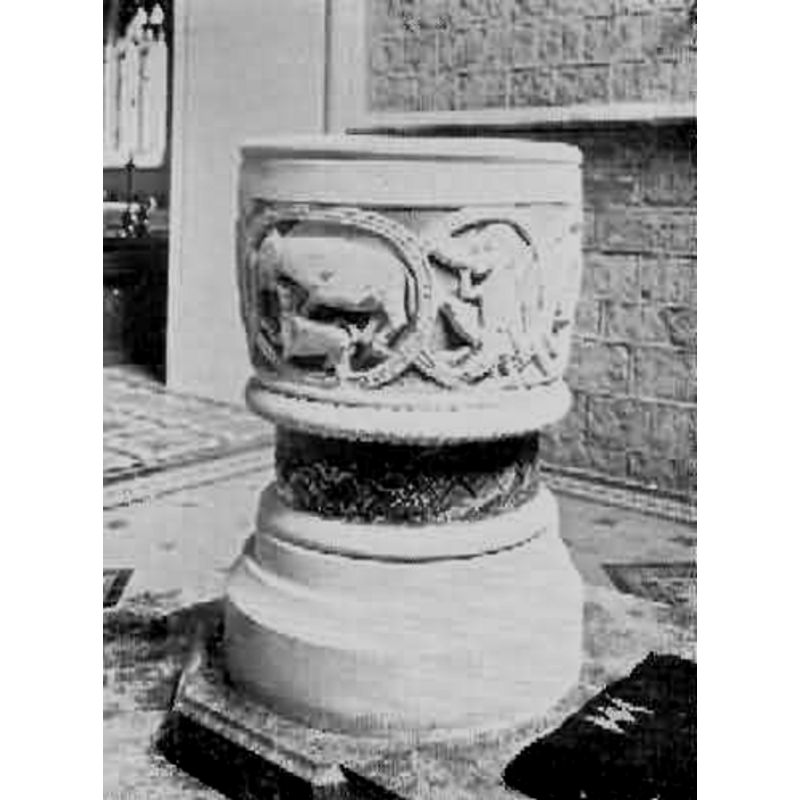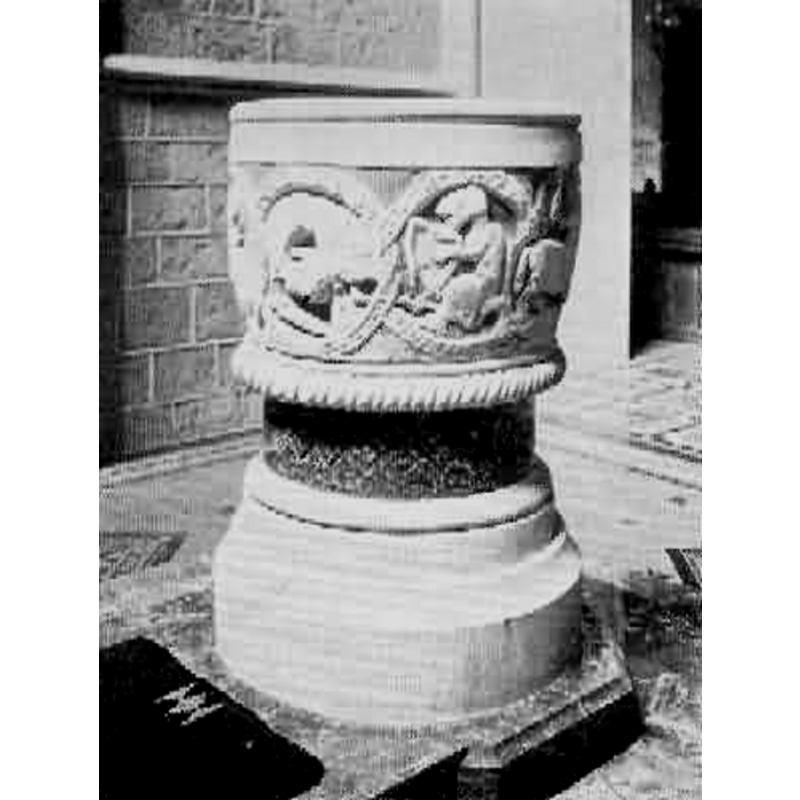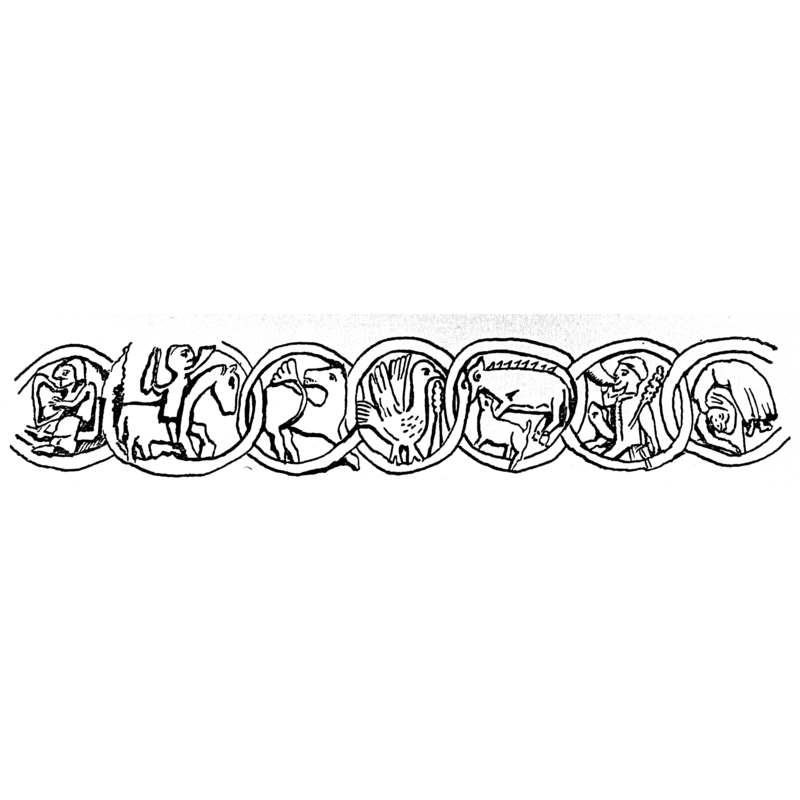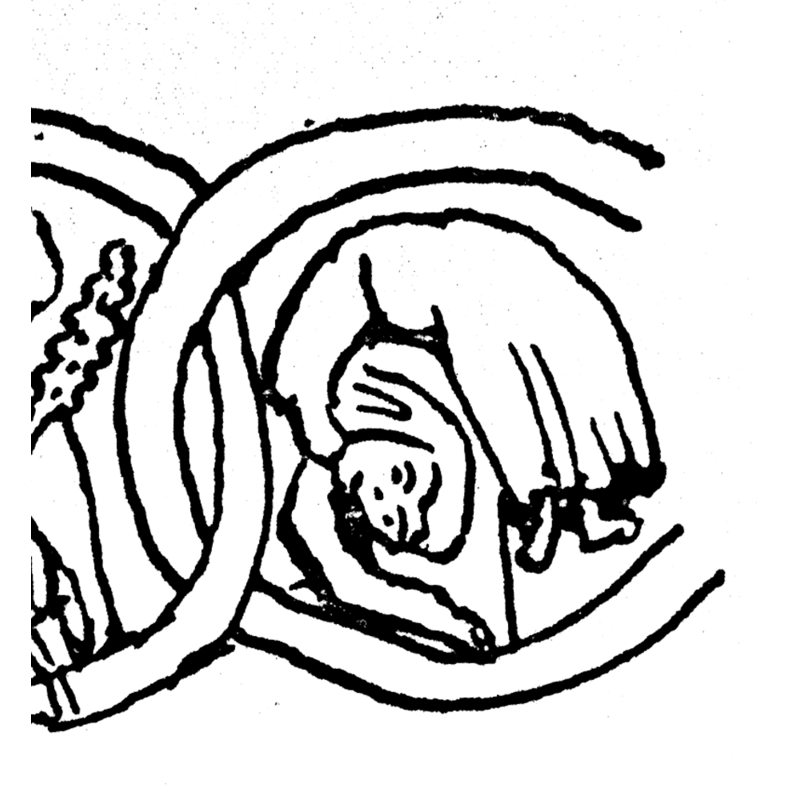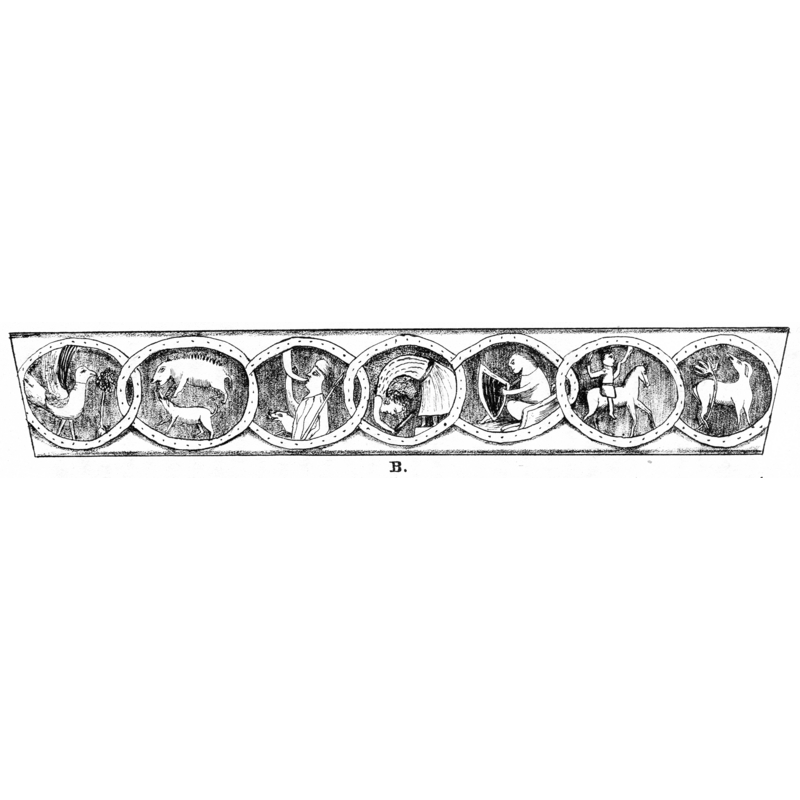St. Marychurch nr. Torquay / St. Mary Church / Saint Marychurch

Image copyright © Baptisteria Sacra Index, 2023
Results: 22 records
B01: design element - motifs - interlace - beaded-tape
B02: human figure - artisan - acrobat - carrying sword - executing summersault? - dancing? - Salome?
B03: Old Testament - story of David - with harp
B04: human figure - male - hunter - on horseback - with horn - with sword
B05: animal - mammal - lion - gardant
B06: animal - bird - dove - eating fruit?
B07: animal - mammal - dog - boar - fighting
B08: human figure - male - hunter - with horn - with spear - sitting
BBL01: design element - motifs - rope moulding
information
information
view of font
view of font
view of font
view of font
view of font
view of font
view of font
view of font
view of font - iconographic program
view of font - iconographic program - detail
INFORMATION
FontID: 02487MAR
Object Type: Baptismal Font1
Church/Chapel: Parish Church of St. Mary the Virgin
Church Patron Saints: St. Mary the Virgin
Church Location: St. Marychurch, Torquay TQ1, United Kingdom
Country Name: England
Location: Devon, South West
Directions to Site: St. Marychurch [aka St. Mary Church] is now a district within Torquay, towards the NW.
Font Location in Church: Inside the church, in the W end of the nave
Century and Period: 11th - 13th century, Norman
Credit and Acknowledgements: We are grateful to the Library at Princeton University for facilitating access to a copy of Oliver's book -- We are also grateful to Dr. Roger Peters, of www.wissensdrang.com, for his permission to use the transcription of and images from Stabb (1908). -- We are grateful to Rita Wood for her information on, and her photographs of this font.
Church Notes: According to the church guide (p. 3) a church is said to have been existed in Saxon times (ca. 1050) in the manor belonging to bishop Leofric of Exeter and later replaced by a Norman church. Under William I [i.e., the Conqueror], it passed to bishop Osborn and is said to be "one of the earliest churches in the area dedicated to Our Lady" (ibid.)
Font Notes:
Click to view
Clarke (1907) and (1913) [after Oliver (1840-1842), who reproduces the communication and drawing from the Rev. E. Kitson] informs that this font was originally a tub and "in 1824 it was dug up from under the existing font, of which, inverted , it formed the base, the sculptured part which now is the bowl being entirely buried. The Rev. Edward Kitson sent it to Dr. Oliver, who reproduced it in his Ecclesiastical Antiquities [cf. supra]. It is very sad that it should have been mutilated, but the block must have been sawn in half, and only the upper part used when it was made up again, associated with incongruous polished marble [...] It is richly ornamented. Seven panels formed of interlaced beaded rings enclose figure subjects. Two of these panels represent hunters, two give the animals they are hunting; the two westernmost are a harper and a dancing girl, the easternmost one is a dove". Despite some claims to the Saxon origin of the basin sculpture, the font at St. Marychurch is probably Norman and can be dated to the 11th-13th century, according to the church guide; the basin is the only original part, carved of a single block of "Beer stone" [cf. church guide, p. 2]. The same source credits E. Kitson, the incumbent vicar in 1824, for the unearthing of the font and its restoration [ibid.] The basin sides contain seven large circles of beaded-tape design. Inside the circles are: 1)acrobat armed with sword performs a somersault(?); 2)a harpist; 3)a hunter on horseback blowing horn and carrying sword; 4)a lion; 5)a bird eating from a plant); 6)a boar being attacked by dog; 7)a hunter armed with a spear and sitting on his haunches blows a hunting horn. The bottom rim of the basin has a rope motif. The plain round base, in two volumes, is modern, probably of the 19th century. NB: the original description of the subjects by the Rev. Edward Kitson (letter of Nov. 23, 1824) should be noted, as his identification of the subjects would have influenced his rendering of the program: "The larger end of the ancient stone is ornamented with a rim of about twelve inches in depth [i.e., height], consisting of seven rings, intersecting each other, and decorated with beads or studs; within these rings are figures of the rudest execution and grotesque character, and are as follows: 1st.- A bird, (probably a dove) with a bunch of grapes or olives in its beak. 2nd.- A boar baited by a dog. 3rd.- A man with a bugle in his right hand, and a dof by his right side, his left hand holding a spear. 4th.- A man falling head over heels, nearly doubled, with a sword in his hand. Q. if Goliath? 5th.- A figure sitting in a chair, playing on a harp. Q. if David? 6th.- Aman on horseback, blowing a bugle, which he holds in his left hand, with a sword in his right. 7th.- A Salamander, emblematic of fire, with the head regardant." Stabb (1908-1916) writes: "The great object of interest in this church is the old font [...]. There is a rather remarkable history attached to it. Before 1824 the lower part was uppermost and the upper part was buried in the floor. In 1824 the floor was repaired when the carving was discovered on the lower portion; on examination this proved to be the original font and it was then placed in its original position. The bowl is ornamented with a rim about twelve inches in depth, consisting of seven rings intersecting each other and decorated with beads or studs; within these rings are carved figures of very rude workmanship." Stabb (ibid.) proceeds to reproduce Oliver's identification and then comments on them: "I have given the list of carvings with Dr. Oliver's ideas as to the meanings, but I think he is incorrect in his conclusions. Of course, when dealing with symbolism in art it is possible to start with a preconceived idea, and to make everything work in with that idea. Necessarily where there are no documents in existence describing what the carvers of the font intended to represent, imagination must come largely into play in deciphering the carvings." After this, Stabb (ibid.) proceeds to comment on three other reporters of the font: "There have been at least three papers published on this font: those by Miss Minna Gray, Miss Kate M. Clarke, and Miss Mary Salter. To take the last first, Miss Salter placed the date of the font long before Saxon times, in fact she does not think it was originally used as a font but as a divining well. The following account of its origin is from her point of view:— 'The church of the parish of St. Mary Church is the fourth which has been built on the same site; a Phœnician church probably once occupied the same spot, as I found the font to have been an ancient divining well, containing a valuable record of the religious and physical history of the Phœnicians and Cimmerians. The seven-ringed carving has been inscribed at various times with Phœnician or Archaic Hebrew characters, Greek and Egyptian letters and hieroglyphs; lastly, it was whitewashed, and that part of Domesday Book which relates to the neighbourhood painted in a darker tone on it. This has nearly all disappeared under the vigorous cleaning to which the font has been subjected. The character inscribed on it form a valuable link between the north western and south eastern alphabets. The original font was funnel shaped; it has been turned upside down and the carving buried to preserve it from the Puritans, and an octagonal top placed on the upturned bottom.' Miss Minna Gray, in her paper read before the Exeter Diocesan Archæological and Architectural Society, in 1905, divides the carvings into three pairs and a single panel. The first two, the boar baited by a dog, and the man with a bugle, she thinks represents a hunt; the hunter a priest, for he is arrayed in a chasuble, and the quarry the unclean swine, symbolical of demonical possession; or, in other words, these panels are symbolical of the casting of the Devil and all his works. The next two panels, the dancing girl* and the harper, Miss Gray thinks are fitting types of the pomps and vanities of the world renounced in baptism. (* Dr. Oliver is clearly wrong in describing this figure as a man; the accordion-pleated skirt can be plainly seen on the panel here, which is almost identical with the carving on the font at South Milton.) The third pair of panels represent another hunting scene, a mounted hunter pursuing a beast of undefined species. This Miss Gray thinks represent the evil one pursuing souls. In E. P. Evans' Animal Symbolism in Ecclesiastical Architecture is an illustration of a scene very similar in which the animal is called a beaver; after a description of the engraving follows this passage, 'But though, O man, separate from thyself the works of the flesh . . . . and throw them to the devil who hunteth after thy soul, saying 'I will pursue my enemies and overtake them.' Then canst thou exclaim with the Psalmist, 'our soul is escaped as a bird out of the snare of the fowler; the snare is broken and we are escaped.'' To quote Miss Gray, 'Surely this is what we have represented on the font; the third renunciation of the baptismal vow; and the result of that threefold renunciation we find just as described above, the soul as a bird escaped and feeding on the Tree of Life' (depicted on the seventh panel). Miss Clarke, in her paper in Devon Notes and Queries for January 1907, differs from Miss Gray in her interpretation of the carvings in several particulars. Firstly, she objects to the dividing of the panels into three pairs, and a single panel, for the reason that the greatest importance was attached to mystic value of numbers, and especially the number seven. 'Three is the number of the Trinity, and consequently, of the soul made in the image of the Trinity, and indicates all spiritual things; four, the number of the elements, is the symbol of natural things, of the body, of the world which resulted from the combination of the four elements.' She [i.e., Clarke] therefore divides the panels into two parts of four and three each; three of a spiritual and four of a natural nature. As to the meaning of the panel representing the dancer and the harpist, Miss Gray and Miss Clarke agree that it symbolises sensual pleasure; but Miss Clarke thinks that the idea that the horseman is the evil one pursuing souls is open to question, she rather thinks that it is intended to represent a preacher whose forcible arguments are symbolised by the horn and the knife. Miss Clarke considers the beaver to be more probably a wild ass — a beast of bad character — symbolising the sinner, and the bird to represent the Church. To sum up, Miss Gray considers the whole series of panels to represent the three-fold renunciation of the baptismal vow, and the soul's escape as the result of that renunciation, while Miss Clarke considers the meaning to be that the two hunters have turned their backs on the world and the flesh, and are driving sinners into church. May we not have here the result of baptism, the regenerate soul that has renounced the world, the flesh, and the Devil, feeding on the Tree of Life, a privilege belonging only to those who have been baptised?" In Pevsner (1952). Studied in detail in Wood (2004), who concludes the programme on the font sides had primarily didactic goals, probably from a series of pattern books, though,Wood notes, this particular set of images is original and not repeated in any other font, which implies a local selection of themes from the patern books; Wood further concludes: "The font in St. Mary's was made by a local stonemason following patterns supplied to him by priest or patron. Its lively eye-catching scenes and odd animals spell out a message about the everyday Christian life for which baptism was the initiation."
COORDINATES
Church Latitude & Longitude Decimal: 50.482, -3.524
Church Latitude & Longitude DMS: 50° 28′ 55.2″ N, 3° 31′ 26.4″ W
UTM: 30U 462823 5592355
MEDIUM AND MEASUREMENTS
Material: stone, beer stone
Number of Pieces: three
Font Shape: round (mounted)
Basin Interior Shape: round
Basin Exterior Shape: round
Drainage Notes: lead lining
Rim Thickness: 10 cm
Diameter (inside rim): 45 cm **[46 cm]
Diameter (includes rim): 66 cm *[65 cm]
Basin Depth: 20 cm **[20 cm]
Basin Total Height: 51 cm
Height of Base: 53 cm
Font Height (less Plinth): 104 cm
Notes on Measurements: BSI *[measurement given in inches in Clarke (1913: 329)] -- Kitson [cf. FontNotes] gives the width of the carved band as 12 inches [=30 cm] approximately -- ** [sent by Rita Wood [letter to BSI of 16 January 2008]
REFERENCES
Betjeman, John, An American's Guide to English Parish Churches (including the Isle of Man), New York: McDowell, Obolensky, 1958
Clarke, Kate M., "The baptismal fonts of Devon -- Part I", 45, Report and Transactions of the Devonshire Association for the Advancement of Science, Literature and Art, 1913, pp. 314-329; p. 326, 329
Clarke, Kate M., "The symbolism of the ancient fonts of Stoke Canon, St Mary Church and Alphington", IV:V (1907), Devon and Cornwall Notes & Queries, 1907, pp. 129-139 and plates; p. 129-139
Drake, Colin Stuart, "Romanesque Fonts in Kent: the French Connections", CXXIII, 2003, Archaeologia Cantiana, 2003, pp. 333-352; p. 342
Gray, Minna, "Symbolic art as illustrated by the Romanesque Font at St. Marychurch", 3rd series, vol. 2 (1907), Exeter Diocese Archaeological Society, 1907, pp. 160-166; p. 160-166
Oliver, George, Ecclesiastical Antiquities in Devon: being Observations on Several Churches in Devonshire, with some Memoranda for the History of Cornwall, Exeter: W.C. Featherstone, 1840-1842
Pevsner, Nikolaus, South Devon, Harmondsworth: Penguin Books, 1952
Stabb, John, Some old Devon churches, their roods, pulpits, fonts, etc., London: Simkin, [et al.], 1908-1916
Tisdall, M. W., God's beasts: identify and understand animals in church carvings, England: Charlesfort Press, 1998?
Wood, Rita, "The Romanesque font at St Marychurch, Torquay", 62 (2004), Proceedings of the Devon Archaeological Society, 2004, pp. 79-98; p. 79-98
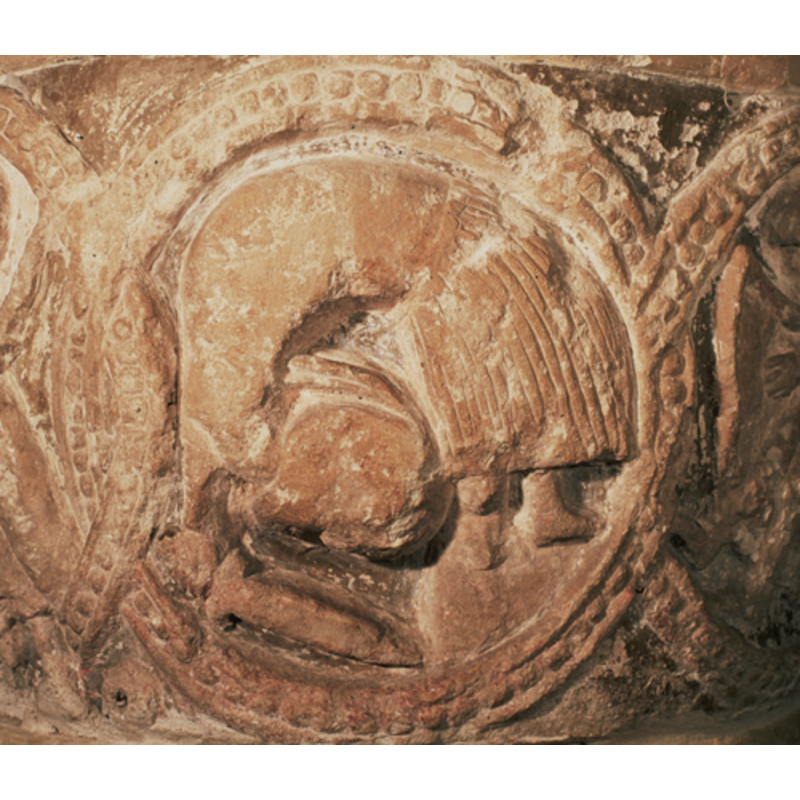

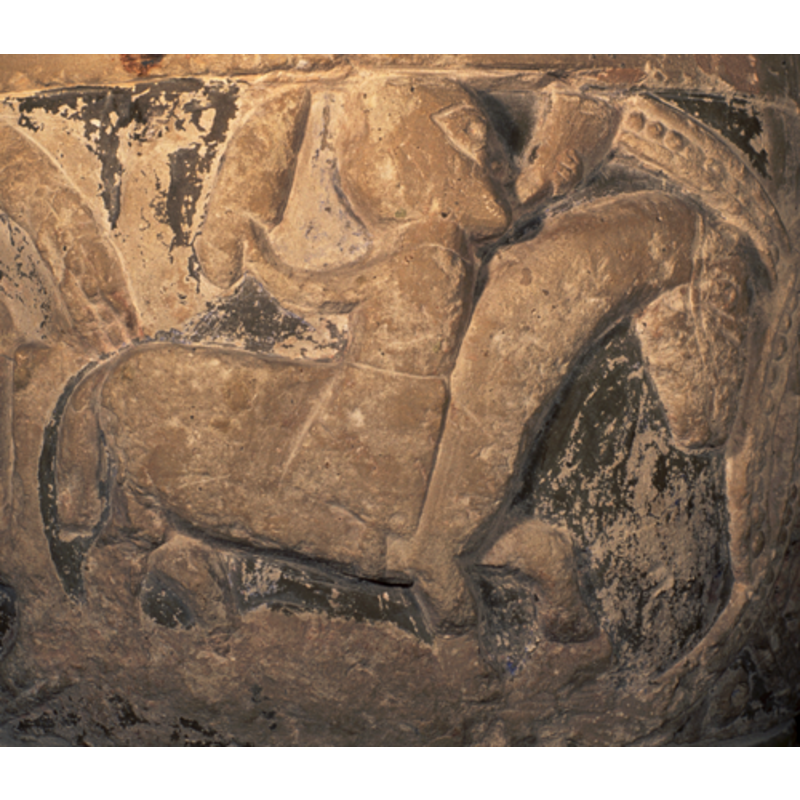

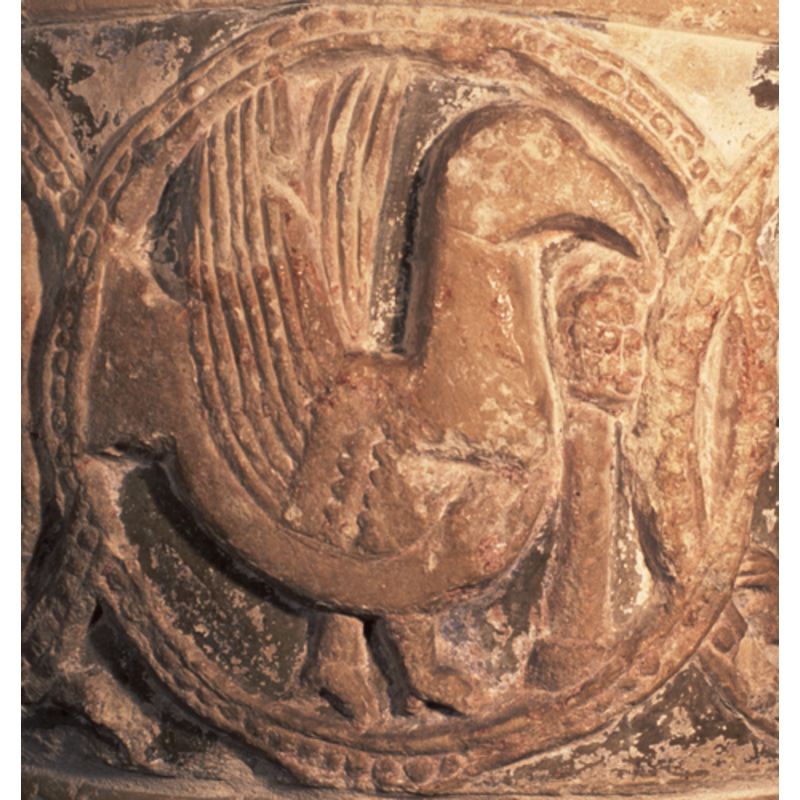
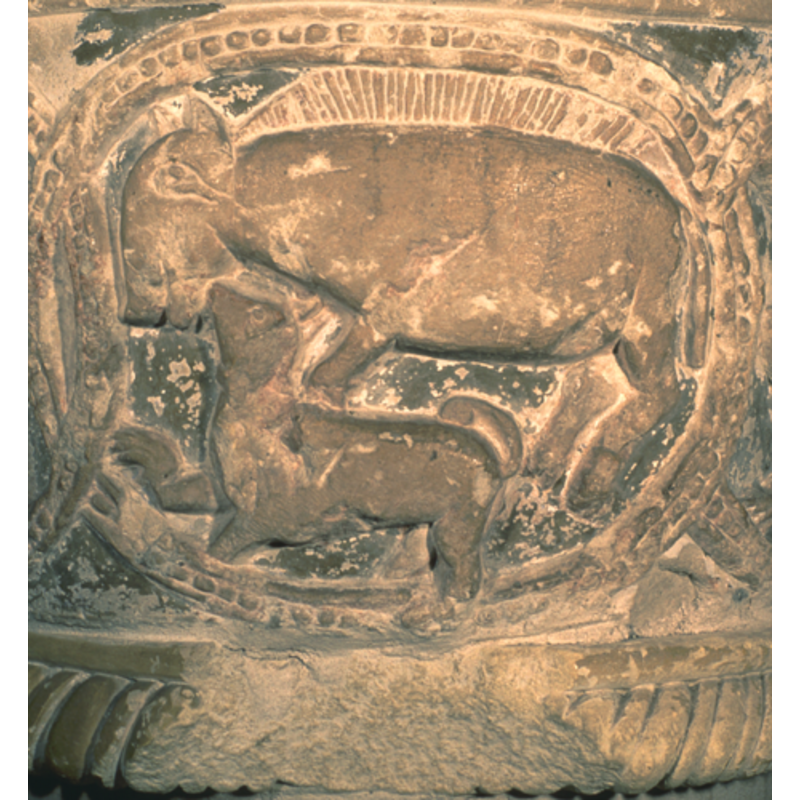
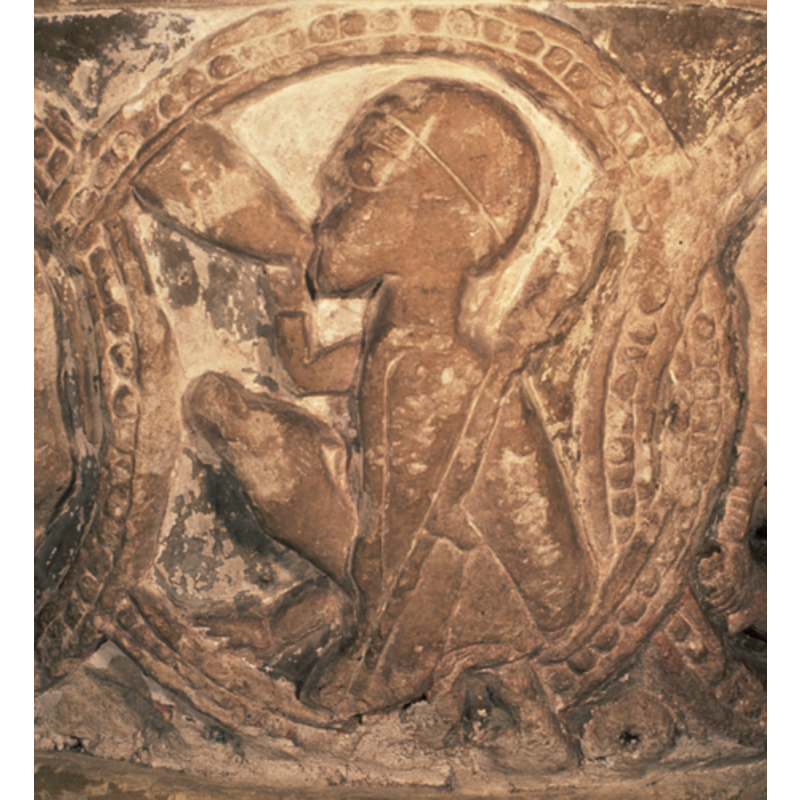

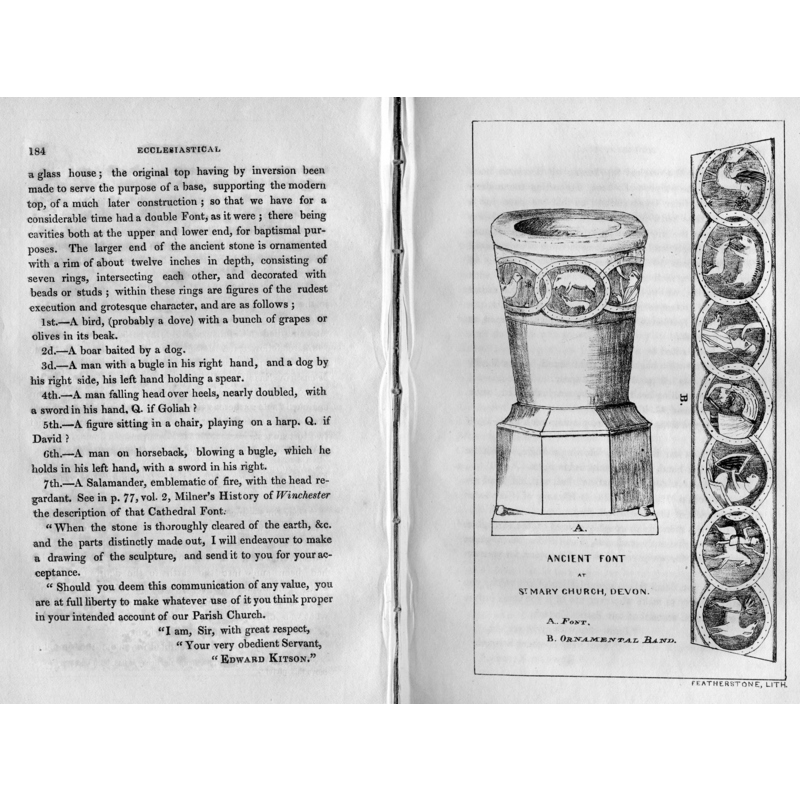
![The font as found [reversed] in 1824](/static-50478a99ec6f36a15d6234548c59f63da52304e5/compressed/0050109002_compressed.png)
![The font, with the carved band buried in the ground, as found in 1824 [cf. Font notes]](/static-50478a99ec6f36a15d6234548c59f63da52304e5/compressed/0050109003_compressed.png)
